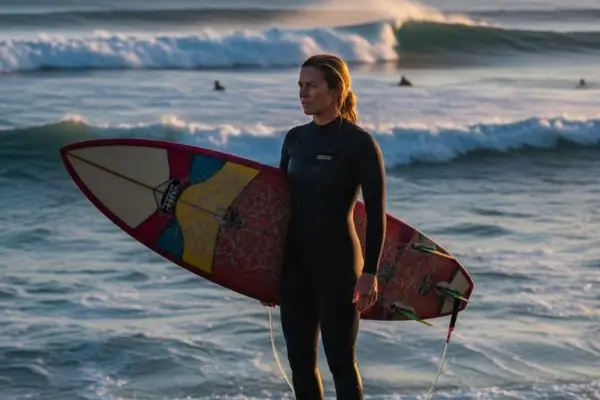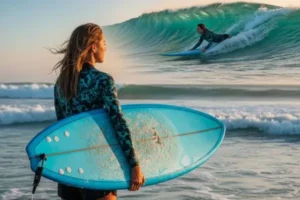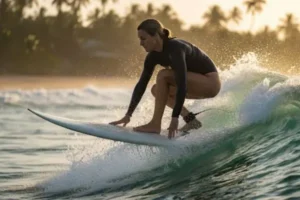Maya had been surfing for only a few months. She had her board, her wetsuit, and plenty of enthusiasm. But each time she paddled out, the same thing happened: she’d either miss the wave, pick the wrong one, or get caught in a messy section. One morning, a more experienced surfer smiled and told her, “Surfing isn’t only about riding waves — it’s about learning which waves to ride.”
This advice changed everything. Wave selection is one of the most overlooked skills for beginner women surfers, yet it’s the one that makes the biggest difference.
Why Wave Selection Matters
- Energy Saver: Choosing the wrong wave means wasted paddling.
- Safety Factor: The right wave gives you control; the wrong one can leave you in the impact zone.
- Progress Accelerator: Good wave choice allows faster learning and more enjoyable sessions.
How to Read the Ocean
Before selecting waves, surfers need to learn how to “read” the ocean. This skill develops over time, but there are key elements to notice right away:
- Wave Shape: Look for waves with a clean face, not closeouts that break all at once.
- Peak Location: Identify where the wave starts to break — this is the sweet spot.
- Consistency: Notice the sets; waves often come in groups.
- Crowd Factor: Sometimes the “best” wave is the one with fewer people on it.
Step-by-Step Guide for Wave Selection
Step 1: Observe Before Entering
Spend at least 5 minutes on the shore watching the ocean. Notice where waves break, how they reform, and where surfers are catching rides.
Step 2: Position Yourself Correctly
Sit where the waves start to form, not too far inside. Beginners often sit too close to shore, which results in late takeoffs.
Step 3: Focus on One Wave at a Time
Instead of chasing every ripple, pick a wave, commit, and paddle with confidence.
Step 4: Choose the Shoulder, Not the Closeout
Look for waves that peel sideways, giving you space to ride, instead of ones that collapse all at once.
Step 5: Learn to Let Waves Pass
Not every wave is worth taking. Sometimes the best choice is waiting for a cleaner one behind.
Common Mistakes Women Beginners Make
- Going for Every Wave: This leads to exhaustion and frustration.
- Sitting Too Deep or Too Inside: Both make catching waves harder.
- Ignoring Set Patterns: Waves often come in series; understanding this helps with timing.
- Following the Crowd Blindly: Just because everyone is paddling doesn’t mean it’s the right wave.
Practical Drills to Improve Wave Selection
- Shadow Surfing: Watch an experienced surfer and observe the waves they choose.
- Silent Sessions: Spend a surf session focusing only on wave observation, not riding.
- Video Review: If possible, record yourself and analyze which waves you picked and why.
Voices from Women Surfers
Many women beginners share the same early struggle: being caught in waves that close out or missing good ones entirely. Over time, however, the process of learning to select waves becomes empowering.
As one surfer put it: “The day I caught my first clean shoulder, I realized surfing wasn’t about luck. It was about patience and paying attention.”
Finding Your Rhythm
Wave selection isn’t just a technical skill — it’s a rhythm between surfer and ocean. For women learning the craft, it’s also a metaphor for confidence: trust your instincts, commit fully, and know that letting go is sometimes as important as taking action.
Each time you paddle out, the sea gives you choices. With practice, you’ll learn not just to catch more waves, but to catch the ones that truly carry you forward.




